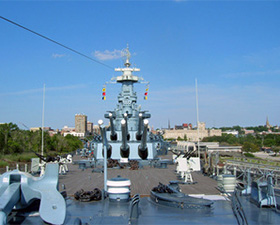North Carolina's Historic Military Sites
Notable Attractions in the Tarheel State
by J. M. Pressley
First published: May 11, 2010
If you're a fan of military history planning a trip into North Carolina, here are some places you won't want to miss.
North Carolina is a state rich in history. From the Outer Banks to the Appalachians, the Tarheel state offers a wide range of attractions available to visitors. Some of its most popular historic sites are its military parks and memorials. If you're a fan of military history planning a trip into North Carolina, here are some places you won't want to miss.
Alamance Battleground
In May of 1771, the royal governor William Tryon led 1,000 troops into the Piedmont to quell a tax rebellion brewing in the western counties. Standing against him at Alamance Creek were 2,000 local militiamen known as Regulators. The Regulators fought a brief, albeit disorganized, battle and lost. Due to its nature and timing, some historians have referred to the battle as a prelude to the American Revolution. Alamance Battleground is located just south of Burlington, NC.
Website: http://www.nchistoricsites.com/alamance/alamanc.htm
Bentonville Battlefield
In spring of 1865, the Union army under Gen. William T. Sherman was on the march northward up through the Carolinas. As Sherman advanced on Goldsboro, NC, Gen. Joseph E. Johnston faced off against him in what was to be the last major Confederate action of the Civil War. After two days of fighting, Johnston's heavily outnumbered troops retreated under cover of darkness. Bentonville Battleground is located near Four Oaks, NC.
Website: http://www.nchistoricsites.com/bentonvi/bentonvi.htm
Brunswick Town/Fort Anderson
Brunswick Town was a major port on the Cape Fear River in the days before the Revolution before the rise of Wilmington. British troops razed the town in 1776, and it was never rebuilt. During the Civil War, Confederate forces built Fort Anderson on the old colonial site to help defend the river. Once Fort Fisher had surrendered, however, the fort was doomed. The Confederates abandoned the fort in the night after three days under fire from land and sea. Brunswick town is located near Winnabow, NC.
Website: http://www.nchistoricsites.com/brunswic/brunswic.htm
Fort Dobbs
Fort Dobbs was erected in 1755 near present-day Statesville in response to the French and Indian War. In that region, it was the only government military installation between southern Virginia and South Carolina. By 1761, however, with the war coming to a close and the frontier pushing further westward, the fort was eventually abandoned. In 1940, the local chapter of Daughters of the American Revolution arranged for the construction of a log cabin visitor's center on the site, and archaeological excavations have been ongoing since 1967. Fort Dobbs State Historic Site is located north of Statesville, NC.
Website: http://www.fortdobbs.org
Fort Fisher
Known in its day as the "Gibraltar of the South," Fort Fisher was the main defense keeping the vital port of Wilmington open for the majority of the Civil War. It was an enormous series of sand dune and earthwork palisades, making it nearly impervious to Union shelling. It took the largest amphibious assault in history at that time to capture the fort on January 15, 1865. Approximately ten percent of the fortifications remain today. Fort Fisher State Historic Site is located in Kure Beach, NC.
Website: http://www.nchistoricsites.org/fisher/fisher.htm
Fort Macon
Work on Fort Macon began in 1826, part of a nationwide campaign to improve coastal defenses. The fort would guard the crucial Beaufort Inlet, gateway to Beaufort, North Carolina's only major deepwater ocean harbor. From the 1830s until the Civil War, the fort was rarely garrisoned. Confederates took the fort two days after the war began, occupying it until April of 1862, when Union forces using new rifled cannons shelled Fort Macon into submission. The fort was formally decommissioned in 1903, eventually sold to the state in 1924, and opened in 1936 as North Carolina's first operational state park. Fort Macon State Park is located in Atlantic Beach, NC.
Website: http://www.ncparks.gov/Visit/parks/foma/main.php
Guilford Courthouse National Military Park
In March of 1781, Gen. Nathanael Greene's Continentals met the British led by Gen. Charles Cornwallis at the village of Guilford Courthouse. The brutal battle that ensued was tactically a victory for the British, who held the field at the end of the day. However, Cornwallis lost more than a quarter of his troops in the battle, which forced him out of the Carolinas and toward his subsequent surrender at Yorktown. Guilford Courthouse National Military Park is located near Greensboro, NC.
Website: http://www.nps.gov/guco/index.htm
Moores Creek National Battlefield
On February 27, 1776, patriot militia under command of Col. Alexander Lillington sprang a trap on Loyalist Highlanders en route to Wilmington as they prepared to cross the bridge spanning Moores Creek. The stunning victory propelled North Carolina and the southern colonies toward independence. The park includes a trail with wayside exhibits leading through the battlefield site. Moores Creek National Battlefield is located near Currie, NC.
Website: http://www.nps.gov/mocr/index.htm
USS North Carolina Battleship Memorial
Nicknamed "The Showboat," the North Carolina was commissioned in 1941 and was the first new American battleship to enter service in World War II. She saw action in every major campaign of the Pacific and became the most decorated battleship of the war, earning 15 battle stars. The U.S. Navy sold the ship to North Carolina in 1961 after a statewide fundraising campaign. The battleship now resides in permanent mooring at Wilmington as a museum ship; in 1986, the ship was added to the National Historic Landmark list. The U.S.S. North Carolina Battleship Memorial is located in Wilmington, NC.
Website: http://www.battleshipnc.com
Sources
North Carolina Historic Sites, North Carolina Division of Parks & Recreation, U.S. National Park Service

The USS North Carolina memorial in Wilmington. (J. M. Pressley/jmpressley.net)
Additional Resources
Did You Know?
The first European fort established in North Carolina was Fort San Juan, built by Spanish explorer Juan Pardo near present-day Morgantown in Burke County in 1567. This predates English colonization by nearly 20 years.